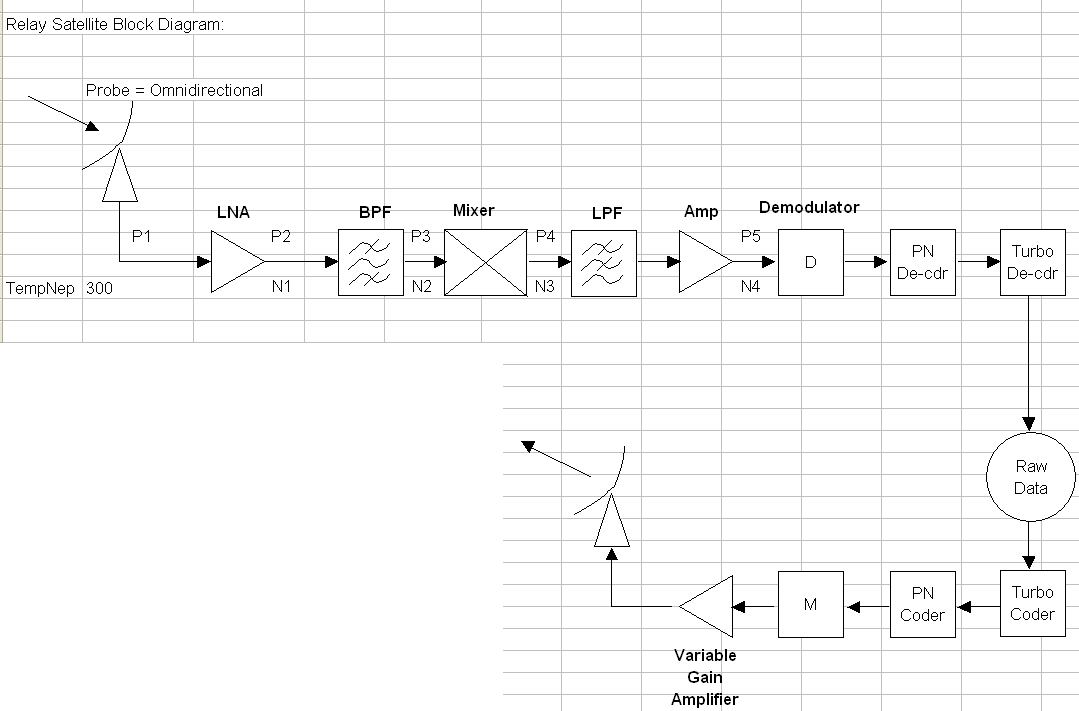Relay Satellite
One relay satellite, placed in geostationary Neptunian orbit, serves to receive the data from the three probes simultaneously using Spread Spectrum techniques.
Power
| The relay satellite is powered by nuclear energy. The power drive is built by Boeing Energy Systems, who has been contracted for an integrated power and propulsion system. While there is some risk of nuclear contamination should there be an accident during launch, nuclear power has been around for a long time and has a perfect track record for powering satellites. |
 |
Data Storage
The relay satellite removes the turbo coding and stores the raw data to a hard drive in a RAID (redundant array of inexpensive disks) to ensure data integrity. A total disk space of 300 GigaBytes is required.
| 8 | kbps | * | 3 | Probes | = | 24 | kbps | * | 25 | Hours | = |
2160000 |
kbits | * | 1024 | / | 8 | = | 276480000 | kBytes | |
| / | 1024 | ||||||||||||||||||||
| 270000 | MBytes | ||||||||||||||||||||
| / | 1024 | ||||||||||||||||||||
| 263.67188 | Gbytes | ||||||||||||||||||||
Communications Bandwidth
Each probe is using 80 kHz of bandwidth. The relay satellite will then be using frequency division multiplexing to re-transmit these signals, for a new bandwidth of 240 kHz.
Communications Block Diagram

Above is the basic communications block diagram for the relay satellite. The relay satellite will be receiving and transmitting using a directional dish antenna. The following is a list of the communication components aboard the Relay Satellite (Click on the model for the Spec Sheet):
Receive Side
| Component | Brand | Model | Specs | Price |
| Low Noise Amplifier | AetherComm | LNA 0.28-0.30-2.0 | 50 dB Gain, 280-300 MHz BW | Not Given |
| Band Pass Filter | Pacific Aerospace & Electronics | Custom Built | 300 MHZ center freq | Not Given |
| Mixer | Dallas Maxim | MAX2685 | $1.40 | |
| Low Pass Filter | Integrated in Amplifier | |||
| Amplifier | AetherComm | LNA 0.28-0.30-2.0 | 50 dB Gain, 280-300 MHz BW | Not Given |
| Demodulator | Analog Devices | AD8348 | QPSK, 50-1000 MHz | $4.95 |
| PN Decoder | Texas Instruments | CDMA2000 1X | Integrated Filter, Amp, and SS Encoder | Not Given |
| Turbo Decoder | ComBlock | COM-7001 | Rate .25 - .97; 64b-4kb Block Length | $375.00 |
Send Side
| Component | Brand | Model | Specs | Price |
| Turbo Coder | ComBlock | COM-7001 | Rate .25 - .97; 64b-4kb Block Length | $375.00 |
| PN Code Modulator | ZiLog | Z8611612(IC) | Integrated PN Coder and QPSK Modulator | Not Given |
| Variable Gain Amp | Analog Devices | AD604 | Ultra Low Noise, 0-48 dB Gain | $17.73 |
Communications Protocol
The relay satellite uses the following protocol to ensure all of the data reaches earth.
| 1 | Transmit in real time from Probes to Relay Satellite |
| Data is saved to hard drive. | |
| 2 | Using onboard almanac, relay satellite will send two series of data FDMA to DSN when earth should be in site (i.e. each packet will be sent twice) |
| DSN will transmit last good packet received. | |
| 3 | After this, relay will commence sending with last good packet received (still using onboard almanac) |
| 4 | If an ack is not received for all data after 10 days, DSN will transmit a continuous pulse of last good packet received. As long as RS sees pulse, will send that and subsequent packets. Once DSN pulse lost, will stop sending (some packets sent will not be received, however when the pulse is picked up again, the relay satellite will know where to start) |
| 5 | RS will remain in location for future missions, but will stop sending data |
| Note | Control signals will occur on different antenna segment |